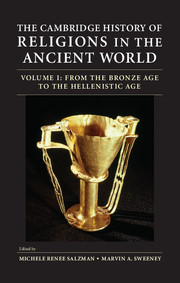Book contents
- Frontmatter
- Contents
- List of Figures and Maps
- List of Contributors
- List of Abbreviations
- Acknowledgments
- Introduction to Volumes I and II
- Introduction to Volume I
- Part I Mesopotamia and the Near East
- Part II Egypt and North Africa
- Part III Greece and the Eastern Mediterranean
- Part IV The Western Mediterranean and Europe
- Suggestions for Further Reading
- General Index
- Index of Citations
- Frontmatter
- Contents
- List of Figures and Maps
- List of Contributors
- List of Abbreviations
- Introduction to Volume II
- Part I Iran and the Near East
- Part II Egypt and North Africa
- 6 Traditional Religion in Ptolemaic and Roman Egypt
- 7 Judaism in Egypt
- 8 Ancient Egyptian Christianity
- 9 Cult and Belief in Punic and Roman Africa
- 10 Christianity in Roman Africa
- Part III Greece and Asia Minor
- Part IV Italy, Roman Gaul, and Spain
- Suggestions for Further Reading
- General Index
- Index of Citations
- References
9 - Cult and Belief in Punic and Roman Africa
from Part II - Egypt and North Africa
Published online by Cambridge University Press: 05 October 2013
- Frontmatter
- Contents
- List of Figures and Maps
- List of Contributors
- List of Abbreviations
- Acknowledgments
- Introduction to Volumes I and II
- Introduction to Volume I
- Part I Mesopotamia and the Near East
- Part II Egypt and North Africa
- Part III Greece and the Eastern Mediterranean
- Part IV The Western Mediterranean and Europe
- Suggestions for Further Reading
- General Index
- Index of Citations
- Frontmatter
- Contents
- List of Figures and Maps
- List of Contributors
- List of Abbreviations
- Introduction to Volume II
- Part I Iran and the Near East
- Part II Egypt and North Africa
- 6 Traditional Religion in Ptolemaic and Roman Egypt
- 7 Judaism in Egypt
- 8 Ancient Egyptian Christianity
- 9 Cult and Belief in Punic and Roman Africa
- 10 Christianity in Roman Africa
- Part III Greece and Asia Minor
- Part IV Italy, Roman Gaul, and Spain
- Suggestions for Further Reading
- General Index
- Index of Citations
- References
Summary
The narrow belt of habitable lands that lines the southern shores of the Mediterranean – between Libya in the East and Morocco in the West – has always been an insular world. From their perspective, the Arab geographers logically named these lands the Jazirat al-Maghrib, the “Island of the West.” The countries that make up North Africa today are thus collectively called “the Maghrib.” The flow of sea currents and the predominant winds, the hard and rugged barrier formed by the coastal mountains, and a location between the world’s largest desert and its largest inland sea, have produced a peculiar mix of connectivity and isolation that has affected both ideas and economies. While moderating the exposure of its inhabitants to influences from elsewhere in the Mediterranean, these same forces have also promoted the rapid development of outside ideas and practices once they have entered North Africa.
One result of this double heritage of relative isolation and internalized intensity was the emergence of a bewildering variety, range, and localized identity of religious ritual and practice among Africans before the arrival of Christianity. In an area larger than that of the Iberian and Italian peninsulas combined, every environmental niche as small as a village or a valley came to have its own spirits, deities, rituals, and festivals. The practices and beliefs were so integrated into the life of each ethnic people, village, cultural or occupational group that they formed an almost out-of-mind part of daily routine. On the other hand, amid all this fragmentation and multiplicity, there was sufficient contact to encourage the formation of strands of unity that can be traced between Africa and the Mediterranean world of which it was part. When a Christian empire during the later fourth century CE began to threaten the local festivals, pilgrimages, parades, and other performances, it was apprehension over the loss of this vital core of everyday life that provoked distress as much as any danger to deeply held beliefs.
- Type
- Chapter
- Information
- The Cambridge History of Religions in the Ancient World , pp. 235 - 263Publisher: Cambridge University PressPrint publication year: 2013
References
- 1
- Cited by

